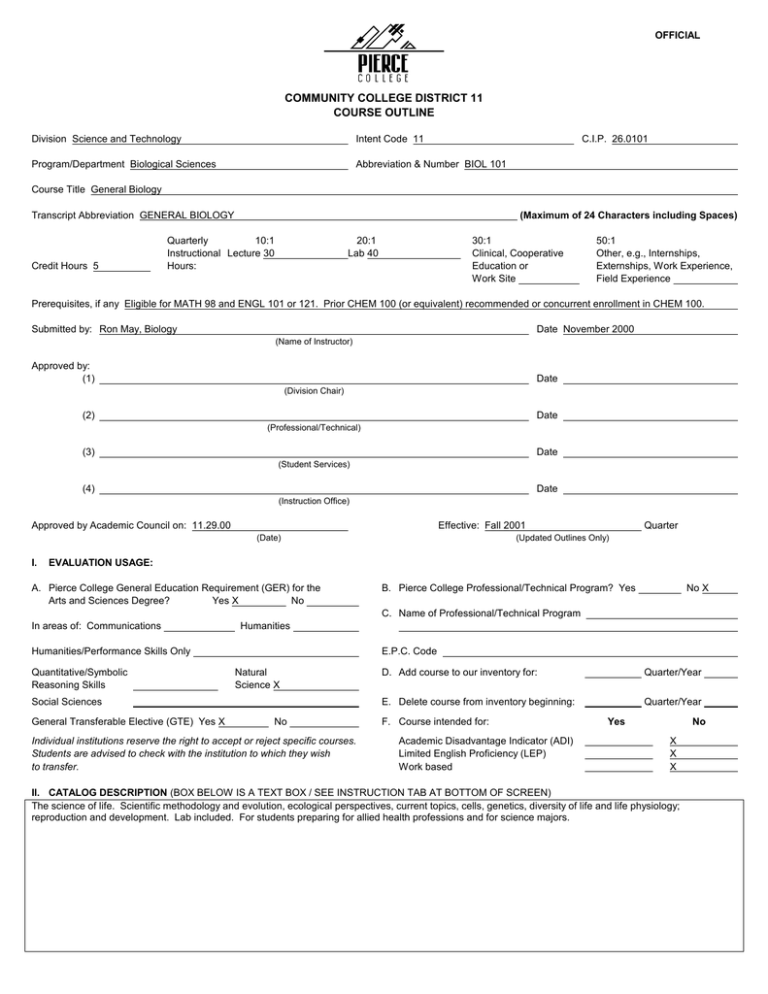COMMUNITY COLLEGE DISTRICT 11 COURSE OUTLINE
advertisement

OFFICIAL COMMUNITY COLLEGE DISTRICT 11 COURSE OUTLINE Division Science and Technology Intent Code 11 C.I.P. 26.0101 Program/Department Biological Sciences Abbreviation & Number BIOL 101 Course Title General Biology Transcript Abbreviation GENERAL BIOLOGY Credit Hours 5 (Maximum of 24 Characters including Spaces) Quarterly 10:1 Instructional Lecture 30 Hours: 20:1 Lab 40 30:1 Clinical, Cooperative Education or Work Site 50:1 Other, e.g., Internships, Externships, Work Experience, Field Experience Prerequisites, if any Eligible for MATH 98 and ENGL 101 or 121. Prior CHEM 100 (or equivalent) recommended or concurrent enrollment in CHEM 100. Submitted by: Ron May, Biology Date November 2000 (Name of Instructor) Approved by: (1) Date (Division Chair) (2) Date (Professional/Technical) (3) Date (Student Services) (4) Date (Instruction Office) Approved by Academic Council on: 11.29.00 Effective: Fall 2001 (Date) I. Quarter (Updated Outlines Only) EVALUATION USAGE: A. Pierce College General Education Requirement (GER) for the Arts and Sciences Degree? Yes X No B. Pierce College Professional/Technical Program? Yes No X C. Name of Professional/Technical Program In areas of: Communications Humanities Humanities/Performance Skills Only Quantitative/Symbolic Reasoning Skills E.P.C. Code Natural Science X Social Sciences General Transferable Elective (GTE) Yes X No Individual institutions reserve the right to accept or reject specific courses. Students are advised to check with the institution to which they wish to transfer. D. Add course to our inventory for: Quarter/Year E. Delete course from inventory beginning: Quarter/Year F. Course intended for: Academic Disadvantage Indicator (ADI) Limited English Proficiency (LEP) Work based Yes No X X X II. CATALOG DESCRIPTION (BOX BELOW IS A TEXT BOX / SEE INSTRUCTION TAB AT BOTTOM OF SCREEN) The science of life. Scientific methodology and evolution, ecological perspectives, current topics, cells, genetics, diversity of life and life physiology; reproduction and development. Lab included. For students preparing for allied health professions and for science majors. COURSE OUTCOMES COURSE NUMBER: COURSE CONTENT: BIOL 101 COURSE TITLE: General Biology This course is designed such that the student becomes familiar with: A. Introduction and scope of biology. B. Basic chemistry and biochemistry. C. Cell structure and function. D. Photosynthesis and cellular respiration. E. Cell division and structure of chromosomes. F. Structure and synthesis of nucleic acids. G. Mandolin genetics. H. Classification of living things, taxonomy. I. Ecology, ecosystem, pollution and population. J. Theories of evolution, speciation. Core Abilities STUDENT OUTCOMES Indicate the desirable results that can be expected to occur from the course experience. These are usually expressed in measurable and observable terms. 1. Describe scientific method; hypothesis, theory principle, and law; summarize the scientific investigative process including experimental and control groups (A,B,C,E,G,M) 2. Describe the structure and function of atoms, ions and molecules; define carbohydrates, lipids, proteins, nucleic acids, ATP, and describe their roles in biological chemistry. (A,B,C,D,E) 3. Define cell and cell theory; describe and explain the ultrastructure of a typical cell; identify cell organelles and describe their functions. (A,B,C,D,E,J,M) 4. Define osmosis, diffusion, active transport, facilitated diffusion, exocytosis and endocytosis; describe the mechanism of above processes; compare and contrast these methods of membrane transport. (A,B,C,D,E,J,M) 5. Describe the mechanism of photosynthesis and cellular respiration; define photosystem, dark reaction, light reaction, glycolysis, Krebs cycle, and chemo-osmosis; also point out where these processes occur in the cell, cell organelle and parts of the cell organelle. (A,B,C,D,E,J,M) 6. Define taxonomy, binomial nomenclature, species and population; describe the five kingdom of life and point out how organisms are classified into these kingdoms. (A,B,C,D,E,G,K,M) 7. Define cell cycle, chromosomes, chromatin, somatic cell, germ cell; describe the various phases of somatic and germ cell division; indicate how mitosis differs from meiosis; discuss what role mitosis and meiosis play in the life of an organism. (A,B,C,D,E,G,K,M). 8. Describe a typical ecosystem; identify producers, consumers, and decomposers; explain food web, food chain and trophic level; analyze terrestrial and aquatic ecosystems and find out how they interact with each other; evaluate the impact of human beings on the environment. (A,B,C,D,E,G,H,I,L) 9. Explain Mendel’s law of segregation and independent assortment; list some human traits which are transmitted/inherited through Mendel’s laws; define allele, homologous chromosome, genotype, phenotype, F1 generation, F2 generation, hybrid, pure breeding variety; describe sex determination; identify some human genetic disorders and their causes. (A,B,C,D,E,G,H,J) 10. Describe Lamarckian theory of acquired characteristics and Darwinian theory of natural selection; explain the mechanism of speciation, microevolution and macroevolution. (A,B,C,D,M) 11. Identify parts of the plant body, the tissue groups and describe their structure and function. (A,B,C,D,E,K,L,M) 12. Survey the organ systems of Kingdom Animalia; identifying epithelial, connective, muscular, and nervous tissues. (A,B,C,D,E,K,L,M) 13. Describe the structure of RNA and DNA; explain and compare and contrast the processes of replication, transcription and translation. (A,B,C,D,E,F,G,J,L,M) 14. Define biotechnology, genetic engineering, cloning, and other DNA therapies; discuss the bioethics and importance of each of these. (A,B,C,D,E,L,M) X X X / X / / X / / X X X / X X X X / / X X X / / X X / / X X X X / X X X X / X X X X X X X / X / / X X X / X X X X X X X X X / X X X X / / METHODS AND TOOLS FOR ASSESSMENT: A. Class attendance/participation. B. Individual/group projects. C. Multi-choice: multiple choice, true-false, fill-in-the-blank, matching. D. Research paper. E. Abstract. F. Journal. G. Laboratory exercise and report. H. Lab practicum. I. Instructor observation. J. Oral presentation. K. Group presentation. L. Group Report. M. Illustrate appropriately labeled tables/figures. N. Dissection. O. Design and implement practice practicum (student-driven). P. Design and submit exam questions. Q. No formal assessment. R. Cadaver (group) session. S. Computer/internet simulations/animations. T. Virtual and real field identification. U. Alternative learning modalities. V. General assessment.